Tutorial_6_solutions
ANSYS ICEM 13.0 Tutorial mannual中文翻译
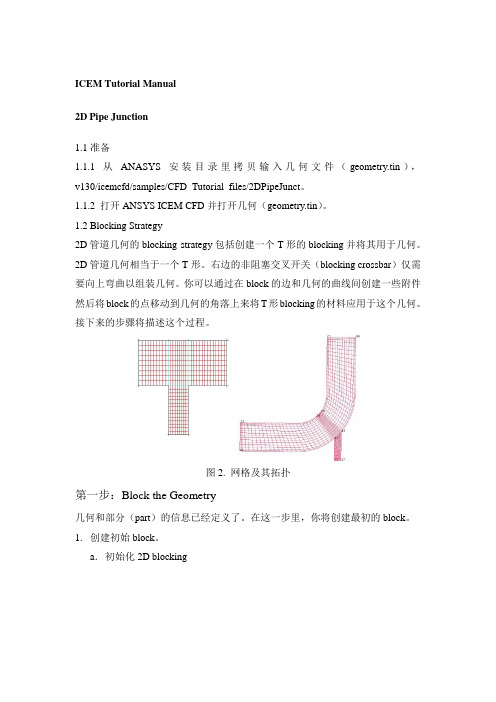
ICEM Tutorial Manual2D Pipe Junction1.1准备1.1.1 从ANASYS安装目录里拷贝输入几何文件(geometry.tin),v130/icemcfd/samples/CFD_Tutorial_files/2DPipeJunct。
1.1.2 打开ANSYS ICEM CFD并打开几何(geometry.tin)。
1.2 Blocking Strategy2D管道几何的blocking strategy包括创建一个T形的blocking并将其用于几何。
2D管道几何相当于一个T形。
右边的非阻塞交叉开关(blocking crossbar)仅需要向上弯曲以组装几何。
你可以通过在block的边和几何的曲线间创建一些附件然后将block的点移动到几何的角落上来将T形blocking的材料应用于这个几何。
接下来的步骤将描述这个过程。
图2. 网格及其拓扑第一步:Block the Geometry几何和部分(part)的信息已经定义了。
在这一步里,你将创建最初的block。
1.创建初始block。
a.初始化2D blockingi.在Part区域中输入FLUID。
ii.在Type下拉菜单中选择2D Plannar。
iii.点击Apply。
b.在Blocking下激活Vertices。
c.在Vertices下选择Numbers。
将blocking下面的Vertices前面的方框勾选,右击,在弹出菜单中选择Numbers即可。
图2给出了包裹几何的初始block。
你将使用这个初始block来创建这个模型的拓扑。
图3. 初始block这些曲线现在被分别上色,并不是由不同部分。
这样可以使你区别不同的曲线实体,这对于某些blocking操作时非常必要的。
你可以通过选择/不选Show Composite激活或者不激活上色命令。
2.将初始block分割为次级block。
本案中,你将使用两个垂直分割和一个水平分割将初始block分割。
LabSolutions 入门指南
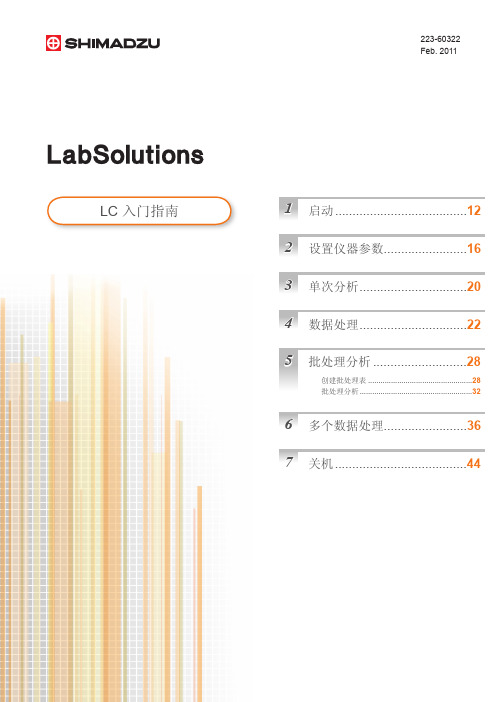
223-60322Feb. 2011 LC 入门指南2本指南版权归株式会社岛津制作所所有。
未经本公司许可不得转载、复制部分或全部内容。
本指南内容如有改动恕不另行通知。
本指南内容力求准确,如有错误或遗漏敬请原谅。
本产品备件的供货期为产品停产后七年。
其后可能无法提供备件,请谅解。
但是,非本公司生产备件的供货期请参照相关厂家的规定。
计算机硬盘中的内容有时会因意外情况而丢失。
请务必备份以保护数据。
如果用户或使用场所发生改变,请将本指南转交给后续用户。
© 2011 Shimadzu Corporation. All rights reserved.••••••声明本指南是英文版《LabSolutions LC 入门指南》(223-60086)(修订版A2010年7月) 的译文。
3LabSolutions 随附有五种使用说明书。
您还可以显示 [帮助] 菜单来确认各参数的含义以及设置范围。
以下内容对如何充分利用这些说明书进行说明。
入门指南本指南供新手用户使用。
请按照本指南中所述步骤的顺序进行分析,以了解基本的 LabSolutions 操作。
操作说明书本说明书提供有关 LabSolutions 中总体数据采集操作的综合信息,例如,系统配置、数据处理、批处理以及报告功能。
管理说明书本说明书供系统管理员使用。
本说明书对系统管理和数据管理进行说明。
理论说明书本说明书对样品成分的峰检测和定量进行说明 (供高级用户使用)。
安装维护说明书本说明书对 LabSolutions 软件的安装和维护进行说明。
帮助参照 [帮助] 可了解有关所显示子窗口的更多信息。
可单击屏幕上的 [帮助] 按钮或键盘上的 [F1] 键显示[帮助]。
说明书中所用符号的含义如下所示。
•创建和打印各种自定义报告系统结构本系统指南就系统使用以下设备采集数据时进行说明。
4文件类型数据文件 (.lcd)该文件包含来自以下文件的所有分析结果和数据采集信息。
教程的英文
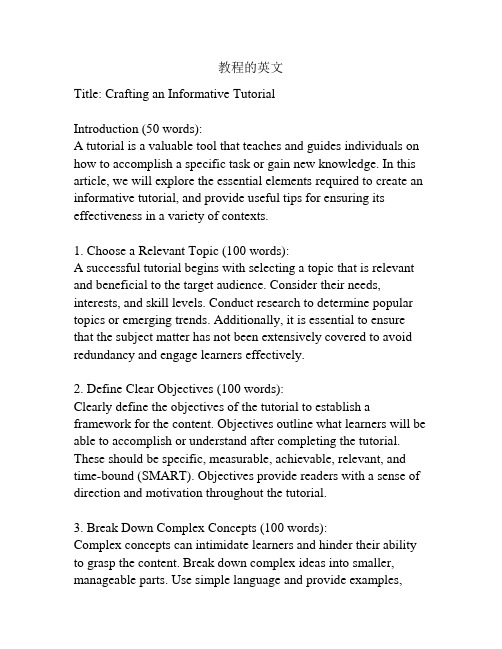
教程的英文Title: Crafting an Informative TutorialIntroduction (50 words):A tutorial is a valuable tool that teaches and guides individuals on how to accomplish a specific task or gain new knowledge. In this article, we will explore the essential elements required to create an informative tutorial, and provide useful tips for ensuring its effectiveness in a variety of contexts.1. Choose a Relevant Topic (100 words):A successful tutorial begins with selecting a topic that is relevant and beneficial to the target audience. Consider their needs, interests, and skill levels. Conduct research to determine popular topics or emerging trends. Additionally, it is essential to ensure that the subject matter has not been extensively covered to avoid redundancy and engage learners effectively.2. Define Clear Objectives (100 words):Clearly define the objectives of the tutorial to establish a framework for the content. Objectives outline what learners will be able to accomplish or understand after completing the tutorial. These should be specific, measurable, achievable, relevant, and time-bound (SMART). Objectives provide readers with a sense of direction and motivation throughout the tutorial.3. Break Down Complex Concepts (100 words):Complex concepts can intimidate learners and hinder their ability to grasp the content. Break down complex ideas into smaller, manageable parts. Use simple language and provide examples,analogies, or illustrations to enhance understanding. Additionally, consider using interactive elements such as quizzes, exercises, or step-by-step instructions to encourage active learning and participation.4. Provide Step-by-Step Instructions (100 words):Step-by-step instructions are a crucial aspect of any tutorial. Present each step clearly and concisely, allowing learners to follow along easily. Use bullet points or numbered lists to organize the instructions effectively. Additionally, incorporating visual aids such as screenshots, diagrams, or videos can enhance comprehension, especially for technical or visual tutorials.5. Include Troubleshooting Tips (100 words):Anticipate common obstacles or challenges learners may encounter during the tutorial and provide troubleshooting tips or solutions. This will aid in preventing frustration and assist learners in overcoming obstacles independently. Including a Frequently Asked Questions (FAQ) section or a troubleshooting guide can be helpful for participants seeking additional assistance. Conclusion (50 words):Creating an informative tutorial requires careful consideration of the target audience, clear objectives, breakdown of complex concepts, step-by-step instructions, and troubleshooting tips. By following these guidelines, tutorial creators can effectively educate and empower individuals to gain new skills, knowledge, or experiences. Remember, a well-executed tutorial is a valuable resource that can make a significant impact on the learning journey of its audience.。
Tutorial_3_solutions
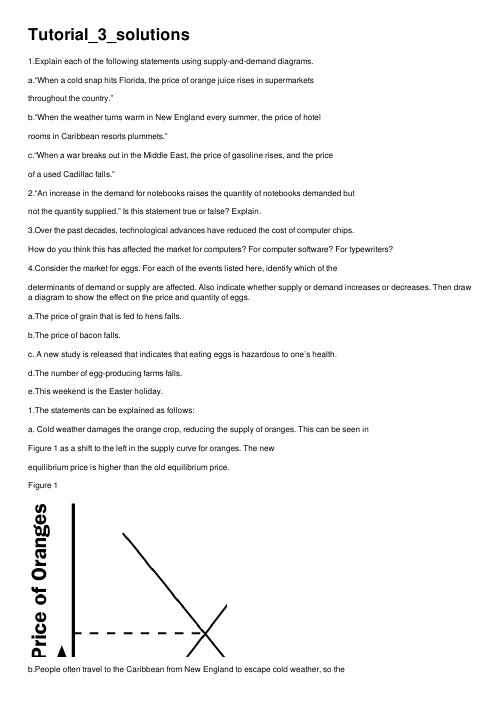
Tutorial_3_solutions1.Explain each of the following statements using supply-and-demand diagrams.a.“When a cold snap hits Florida, the price of orange juice rises in supermarketsthroughout the country.”b.“When the weather turns warm in New England every summer, the price of hotelrooms in Caribbean resorts plummets.”c.“When a war breaks out in the Middle East, the price of gasoline rises, and the priceof a used Cadillac falls.”2.“An increase in the demand for notebooks raises the quantity of notebooks demanded butnot the quantity supplied.” Is this statement true or false? Explain.3.Over the past decades, technological advances have reduced the cost of computer chips.How do you think this has affected the market for computers? For computer software? For typewriters?4.Consider the market for eggs. For each of the events listed here, identify which of thedeterminants of demand or supply are affected. Also indicate whether supply or demand increases or decreases. Then draw a diagram to show the effect on the price and quantity of eggs.a.The price of grain that is fed to hens falls.b.The price of bacon falls.c. A new study is released that indicates that eating eggs is hazardous to one’s health.d.The number of egg-producing farms falls.e.This weekend is the Easter holiday.1.The statements can be explained as follows:a. Cold weather damages the orange crop, reducing the supply of oranges. This can be seen inFigure 1 as a shift to the left in the supply curve for oranges. The newequilibrium price is higher than the old equilibrium price.Figure 1b.People often travel to the Caribbean from New England to escape cold weather, so thedemand for Caribbean hotel rooms is high in the winter. In the summer, fewer people travel to the Caribbean, because northern climes are more pleasant. The result, as shown in Figure 2, is a shift to the left in the demand curve. The equilibrium price of Caribbean hotel rooms is thus lower in the summer than in the winter, as the figure shows.Figure 2c.When a war breaks out in the Middle East, many markets are affected. Because a largeproportion of oil production takes place there, the war disrupts oil supplies, shifting the supply curve for gasoline to the left, as shown in Figure 3. The result is a rise in the equilibrium priceof gasoline. With a higher price for gasoline, the cost of operating a gas-guzzling automobile like a Cadillac will increase. As a result, the demand for used Cadillacs will decline, as people in the market for cars will not find Cadillacs as attractive. In addition, some people who already own Cadillacs will try to sell them. The result is that the demand curve for used Cadillacs shifts to the left, while the supply curve shifts to the right, as shown in Figure 4. The result is a decline in the equilibrium price of used Cadillacs.Figure 3 Figure 42. The statement that "an increase in the demand for notebooks raises the quantity of notebooksdemanded, but not the quantity supplied," in general, is false. As Figure 5 shows, the increasein demand for notebooks results in an increased quantity supplied. The only way the statement would be true is if the supply curve was a vertical line, as shown in Figure 6.Figure 5 Figure 63.Technological advances that reduce the cost of producing computer chips represent a decline in an input price for producing a computer. The result is a shift to the right in the supply of computers, as shown in Figure 7. The equilibrium price falls and the equilibrium quantity rises, as the figure shows.Figure 7Because computer software is a complement to computers, the lower equilibrium price of computers increases the demand for software. As Figure 8 shows, the result is a rise in both the equilibrium price and quantity of software.Figure 8Because typewriters are substitutes for computers, the lower equilibrium price of computers reduces the demand for typewriters. As Figure 9 shows, the result is a decline in both the equilibrium price and quantity of typewriters.Figure 94.The answers are as follows:a.If the price of grain used to feed hens falls, the supply of eggs will rise. Demand will not be affected. The result is a fall in the price and an increase in the quantity sold, as Figure 10 shows.Figure 10b.If the price of bacon falls, the demand for eggs will rise because eggs and bacon are complements. Supply will not be affected. The result is an increase in both the price of eggs and the quantity sold, as Figure 11 shows.Figure 11c. A new study that indicates that eat ing eggs is hazardous to one’s health will cause a decline in the demand for eggs. Supply is not affected. The result is a decline in the price of eggs and a decrease in the quantity sold, as Figure 12 shows.Figure 12d.If the number of egg-producing farms falls, the supply of eggs will decline. Demand isnot affected. The equilibrium price of eggs will fall and quantity of eggs sold rises as Figure13 shows.Figure 13equilibrium price and the equilibrium quantity rise, as Figure 11 shows.。
Chapter 6 - Solid Solutions
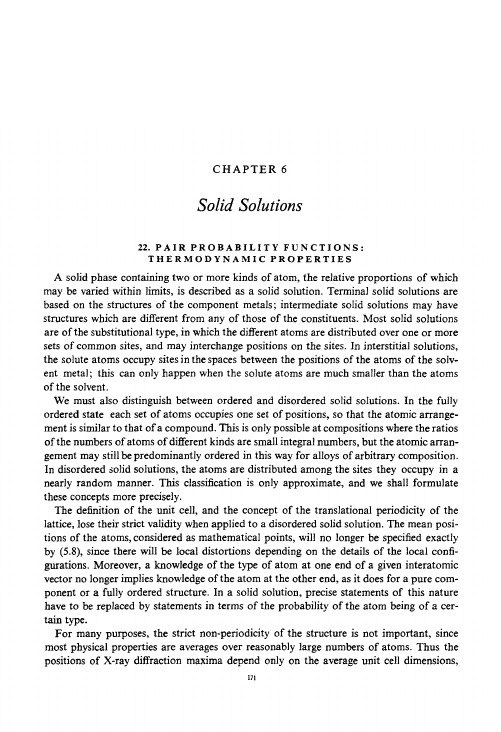
Solid Solutions
22. P A I R P R O B A B I L I T Y F U N C T I O N S : THERMODYNAMIC PROPERTIES
A solid phase containing two or more kinds of atom, the relative proportions of which may be varied within limits, is described as a solid solution. Terminal solid solutions are based on the structures of the component metals; intermediate solid solutions may have structures which are different from any of those of the constituents. Most solid solutions are of the substitutional type, in which the different atoms are distributed over one or more sets of common sites, and may interchange positions on the sites. In interstitial solutions, the solute atoms occupy sites in the spaces between the positions of the atoms of the solvent metal; this can only happen when the solute atoms are much smaller than the atoms of the solvent. We must also distinguish between ordered and disordered solid solutions. In the fully ordered state each set of atoms occupies one set of positions, so that the atomic arrangement is similar to that of a compound. This is only possible at compositions where the ratios of the numbers of atoms of different kinds are small integral numbers, but the atomic arrangement may still be predominantly ordered in this way for alloys of arbitrary composition. In disordered solid solutions, the atoms are distributed among the sites they occupy in a nearly random manner. This classification is only approximate, and we shall formulate these concepts more precisely. The definition of the unit cell, and the concept of the translational periodicity of the lattice, lose their strict validity when applied to a disordered solid solution. The mean positions of the atoms, considered as mathematical points, will no longer be specified exactly by (5.8), since there will be local distortions depending on the details of the local configurations. Moreover, a knowledge of the type of atom at one end of a given interatomic vector no longer implies knowledge of the atom at the other end, as it does for a pure component or a fully ordered structure. In a solid solution, precise statements of this nature have to be replaced by statements in terms of the probability of the atom being of a certain type. For many purposes, the strict non-periodicity of the structure is not important, since most physical properties are averages over reasonably large numbers of atoms. Thus the positions of X-ray diffraction maxima depend only on the average unit cell dime Theory of Transformations in Metals and Alloys
Lab 6 solutions
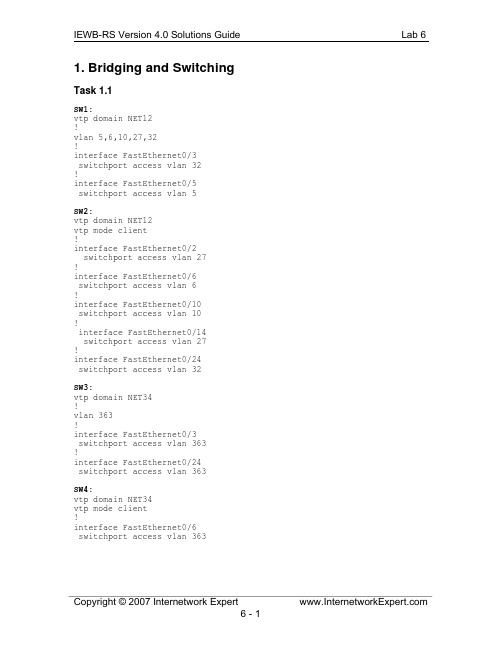
As discussed in previous solutions the default mode for the 3560 is already dynamic auto but the 3550’s default mode is dynamic desirable.
5 VLAN0005
active Fa0/5
6 VLAN0006
active
7 VLAN0007
active
27 VLAN0027
active
32 VLAN0032
active Fa0/3
77 VLAN0077
active
777 VLAN0777
active
Rack1SW2#show vtp status | include (Operating Mode|Domain)
ห้องสมุดไป่ตู้
Rack1SW3#show vtp status | include Domain
VTP Domain Name
: NET34
Rack1SW3#show vlan brief | exclude (unsup|^1 |^ )
Quick Note
The VLANs will not appear on the VTP clients until trunking has been enabled.
switchport access vlan 10 !
interface FastEthernet0/14 switchport access vlan 27
! interface FastEthernet0/24
switchport access vlan 32
ch06partSolution
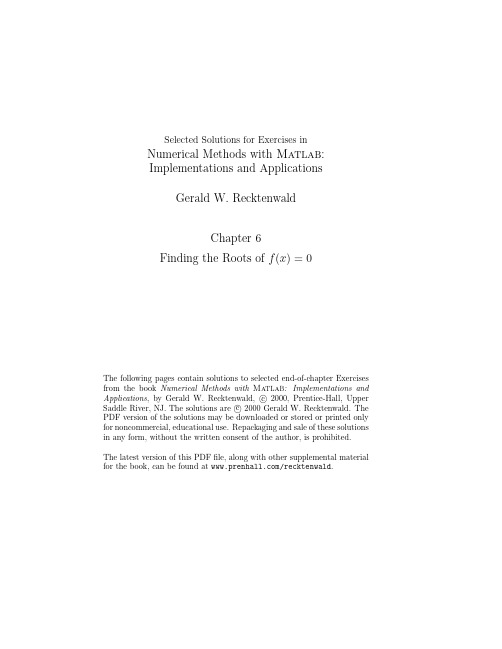
Selected Solutions for Exercises inNumerical Methods with Matlab:Implementations and ApplicationsGerald W.RecktenwaldChapter6Finding the Roots of f(x)=0The following pages contain solutions to selected end-of-chapter Exercisesfrom the book Numerical Methods with Matlab:Implementations andApplications,by Gerald W.Recktenwald,c 2000,Prentice-Hall,Upper Saddle River,NJ.The solutions are c 2000Gerald W.Recktenwald.ThePDF version of the solutions may be downloaded or stored or printed onlyfor noncommercial,educational use.Repackaging and sale of these solutionsin any form,without the written consent of the author,is prohibited.The latest version of this PDFfile,along with other supplemental material for the book,can be found at /recktenwald.2Finding the Roots of f(x)=0 6–2The function f(x)=sin(x2)+x2−2x−0.09has four roots in the interval−1≤x≤3.Given the m-file fx.m,which containsfunction f=fx(x)f=sin(x.^2)+x.^2-2*x-0.09;the statement>>brackPlot(’fx’,-1,3)produces only two brackets.Is this result due to a bug in brackPlot or fx?What needs to be changed so that all four roots are found?Demonstrate that your solution works.Partial Solution:The statement>>Xb=brackPlot(’fx’,-1,3)Xb=-0.15790.05262.1579 2.3684returns two brackets.A close inspection of the plot of f(x)reveals that f(x)crosses the x-axis twice near x=1.3.These two roots are missed by brackPlot because there default search interval is too coarse.There is no bug in brackPlot.Implementing a solution using afiner search interval is left as an exercise.6–11Use the bisect function to evaluate the root of the Colebrook equation(see Exercise8) for /D=0.02and Re=105.Do not modify bisect.m.This requires that you write an appropriate function m-file to evaluate the Colebrook equation.Partial Solution:Using bisect requires writing an auxiliary function to evaluate the Cole-brook equation in the form F(f)=0,where f is the friction factor.The following form of F(f)is used in the colebrkz function listed below.F(f)=1√f+2log10/D3.7+2.51Re D√fMany other forms of F(f)will work.function ff=colebrkz(f)%COLEBRKZ Evaluates the Colebrook equation in the form F(f)=0%for use with root-finding routines.%%Input:f=the current guess at the friction factor%%Global Variables:%EPSDIA=ratio of relative roughness to pipe diameter%REYNOLDS=Reynolds number based on pipe diameter%%Output:ff=the"value"of the Colebrook function written y=F(f)%Global variables allow EPSDIA and REYNOLDS to be passed into%colebrkz while bypassing the bisect.m or fzero functionglobal EPSDIA REYNOLDSff=1.0/sqrt(f)+2.0*log10(EPSDIA/3.7+2.51/(REYNOLDS*sqrt(f)));Because the bisect function(unlike fzero)does not allow additional parameters to be passed through to the F(f)function,the values of /D and Re are passed to colebrkz via global variables.Running bisect with colebrkz is left to the reader.For Re=1×105and /D=0.02the solution is f=0.0490.Copyright c 2000,Gerald W.Recktenwald.Photocopying is permitted only for non-commercial educational purposes.Chapter6:Finding the Roots of f(x)=03 6–13Derive the g3(x)functions in Example6.4and Example6.5.(Hint:What is thefixed-pointformula for Newton’s method?)Partial Solution:Thefixed point iteration formulas designated as g3(x)in Example6.4 and Example6.5are obtained by applying Newton’s method.The general form of Newton’smethod for a scalar variable isx k+1=x k−f(x k) f (x k)Example6.4:The f(x)function and its derivative aref(x)=x−x1/3−2f (x)=1−13x−2/3Substituting these expressions into the formula for Newton’s method and simplifying givesx k+1=x k−x k−x1/3k−21−(1/3)x−2/3k=x k(1−(1/3)x−2/3k)−(x k−x1/3k−2)1−(1/3)x−2/3k=x k−(1/3)x1/3k−x k+x1/3k+21−(1/3)x−2/3k=(2/3)x1/3k+21−(1/3)x k=2x1/3k+63−x−2/3kRepeating this analysis for Example6.5is left as an exercise.Copyright c 2000,Gerald W.Recktenwald.Photocopying is permitted only for non-commercial educational purposes.4Finding the Roots of f(x)=0 6–17K.Wark and D.E.Richards(Thermodynamics,6th ed.,1999,McGraw-Hill,Boston,Example 14-2,pp.768–769)compute the equilibrium composition of a mixture of carbon monoxide and oxygen gas at one atmosphere.Determining thefinal composition requires solving3.06=(1−x)(3+x)1/2 x(1+x)1/2for x.Obtain afixed-point iteration formula forfinding the roots of this equation.Implement your formula in a Matlab function and use your function tofind x.If your formula does not converge,develop one that does.Partial Solution:Onefixed point iteration formula is obtained by isolating the factor of (3+x)in the numerator.3.06x(1+x)1/21−x =(3+x)1/2=⇒x=3.06x(1+x)1/21−x2−3=⇒g1(x)=3.06x(1+x)1/21−x2−3Anotherfixed point iteration formula is obtained by solving for the isolated x in the denomi-nator to getx=(1−x)(3+x)1/23.06(1+x)=⇒g2(x)=(1−x)(3+x)1/23.06(1+x)Performing10fixed point iterations with g1(x)givesit xnew1-7.6420163e-012-2.5857113e+003-1.0721050e+014-7.9154865e+015-7.1666488e+026-6.6855377e+037-6.2575617e+048-5.8590795e+059-5.4861826e+0610-5.1370394e+07Thus,g1(x)does not converge.The g2(x)function does converge to the true root of x= 0.340327....Matlab implementations of thefixed point iterations are left as an Exercise. Copyright c 2000,Gerald W.Recktenwald.Photocopying is permitted only for non-commercial educational purposes.Chapter6:Finding the Roots of f(x)=05 6–24Create a modified newton function(say,newtonb)that takes a bracket interval as input instead of a single initial guess.From the bracket limits take one bisection step to determine x0,the initial guess for Newton e the bracket limits to develop relative tolerances on x and f(x)as in the bisect function in Listing6.4.Solution:The newtonb function is listed below.The demoNewtonb function,also listed below, repeats the calculations in Example6.8with the original newton function and with the new newtonb function.Running demoNewtonb gives>>demoNewtonbOriginal newton function:Newton iterations for fx3n.mk f(x)dfdx x(k+1)1-4.422e-018.398e-01 3.526644293139032 4.507e-038.561e-01 3.521380147397333 3.771e-078.560e-01 3.521379706804574 2.665e-158.560e-01 3.5213797068045750.000e+008.560e-01 3.52137970680457newtonb function:Newton iterations for fx3n.mk f(x)dfdx x(k+1)1-4.422e-018.398e-01 3.526644293139032 4.507e-038.561e-01 3.521380147397333 3.771e-078.560e-01 3.521379706804574 2.665e-158.560e-01 3.5213797068045750.000e+008.560e-01 3.52137970680457The two implementations of Newton’s method give identical results because the input to newtonb is the bracket[2,4].This causes the initial bisection step to produce the same initial guess for the Newton iterations that is used in the call to newton.function demoNewtonb%demoNewtonb Use newton and newtonb to find the root of f(x)=x-x^(1/3)-2%%Synopsis:demoNewton%%Input:none%%Output print out of convergence history,and comparison of methodsfprintf(’\nOriginal newton function:\n’);r=newton(’fx3n’,3,5e-16,5e-16,1);fprintf(’\nnewtonb function:\n’);rb=newtonb(’fx3n’,[24],5e-16,5e-16,1);Copyright c 2000,Gerald W.Recktenwald.Photocopying is permitted only for non-commercial educational purposes.6Finding the Roots of f(x)=0 function r=newtonb(fun,x0,xtol,ftol,verbose)%newtonb Newton’s method to find a root of the scalar equation f(x)=0%Initial guess is a bracket interval%%Synopsis:r=newtonb(fun,x0)%r=newtonb(fun,x0,xtol)%r=newtonb(fun,x0,xtol,ftol)%r=newtonb(fun,x0,xtol,ftol,verbose)%%Input:fun=(string)name of mfile that returns f(x)and f’(x).%x0=2-element vector providing an initial bracket for the root%xtol=(optional)absolute tolerance on x.Default:xtol=5*eps%ftol=(optional)absolute tolerance on f(x).Default:ftol=5*eps%verbose=(optional)flag.Default:verbose=0,no printing.%%Output:r=the root of the functionif nargin<3,xtol=5*eps;endif nargin<4,ftol=5*eps;endif nargin<5,verbose=0;endxeps=max(xtol,5*eps);feps=max(ftol,5*eps);%Smallest tols are5*epsif verbosefprintf(’\nNewton iterations for%s.m\n’,fun);fprintf(’k f(x)dfdx x(k+1)\n’);endxref=abs(x0(2)-x0(1));%Use initial bracket in convergence testfa=feval(fun,x0(1));fb=feval(fun,x0(2));fref=max([abs(fa)abs(fb)]);%Use max f in convergence testx=x0(1)+0.5*(x0(2)-x0(1));%One bisection step for initial guessk=0;maxit=15;%Current and max iterationswhile k<=maxitk=k+1;[f,dfdx]=feval(fun,x);%Returns f(x(k-1))and f’(x(k-1))dx=f/dfdx;x=x-dx;if verbose,fprintf(’%3d%12.3e%12.3e%18.14f\n’,k,f,dfdx,x);endif(abs(f/fref)<feps)|(abs(dx/xref)<xeps),r=x;return;endendwarning(sprintf(’root not found within tolerance after%d iterations\n’,k));Copyright c 2000,Gerald W.Recktenwald.Photocopying is permitted only for non-commercial educational purposes.Chapter6:Finding the Roots of f(x)=07 6–27Implement the secant method using Algorithm6.5and Equation(6.13).Test your program by re-creating the results in Example6.10.What happens if10iterations are performed?Replace the formula in Equation(6.13)withx k+1=x k−f(x k)(x k−x k−1)f(x k k−1,whereεis a small number on the order ofεm.How and why does this change the results? Partial Solution:The demoSecant function listed below implements Algorithm(6.5)using Equation(6.13).The f(x)function,Equation6.3,is hard-coded into demoSecant.Note also that demoSecant performs ten iterations without checking for convergence.function demoSecant(a,b);%demoSecant Secant method for finding the root of f(x)=x-x^(1/3)-2=0%Implement Algorithm6.5,using Equation(6.13)%%Synopsis:demoSecant(a,b)%%Input:a,b=initial guesses for the iterations%%Output:print out of iterations;no return values.%copy initial guesses to local variablesxk=b;%x(k)xkm1=a;%x(k-1)fk=fx3(b);%f(x(k))fkm1=fx3(a);%f(x(k-1))fprintf(’\nSecant method:Algorithm6.5,Equation(6.13)\n’);fprintf(’n x(k-1)x(k)f(x(k))\n’);fprintf(’%3d%12.8f%12.8f%12.5e\n’,0,xkm1,xk,fk);for n=1:10x=xk-fk*(xk-xkm1)/(fk-fkm1);%secant formula for updating the rootf=fx3(x);fprintf(’%3d%12.8f%12.8f%12.5e\n’,n,xk,x,f);xkm1=xk;xk=x;%set-up for next iterationfkm1=fk;fk=f;endCopyright c 2000,Gerald W.Recktenwald.Photocopying is permitted only for non-commercial educational purposes.8Finding the Roots of f(x)=0 Running demoSecant with an initial bracket of[3,4](the same bracket used in Example6.10) gives>>demoSecant(3,4)Secant method:Algorithm6.5,Equation(6.13)n x(k-1)x(k)f(x(k))0 3.00000000 4.00000000 4.12599e-011 4.00000000 3.51734262-3.45547e-032 3.51734262 3.52135125-2.43598e-053 3.52135125 3.52137971 1.56730e-094 3.52137971 3.52137971-8.88178e-165 3.52137971 3.52137971-2.22045e-166 3.52137971 3.521379710.00000e+007 3.52137971 3.521379710.00000e+00Warning:Divide by zero.>In/werk/MATLAB_Book/SolutionManual/roots/mfiles/demoSecant.m at line228 3.52137971NaN NaN9NaN NaN NaN10NaN NaN NaNThe secant method has fully converged in6iterations.Continuing the calculations beyond convergence gives afloating point exception because f(x k)−f(x k−1)=0in the denominator of Equation(6.13).In general,it is possible to have f(x k)−f(x k−1)=0before the secant iterations reach convergence.Thus,thefloating point exception exposed by demoSecant should be guarded against in any implementation of the secant method.Implementing thefix suggested in the problem statement is left as an exercise for the reader.Copyright c 2000,Gerald W.Recktenwald.Photocopying is permitted only for non-commercial educational purposes.Chapter6:Finding the Roots of f(x)=09 6–33Write an m-file function to compute h,the depth to which a sphere of radius r,and specific gravity s,floats.(See Example6.12on page281.)The inputs are r and s,and the output ish.Only compute h when s<0.5.The s≥0.5case is dealt with in the following Exercise.If s≥0.5is input,have your function print an error message and stop.(The built-in error function will be useful.)Your function needs to include logic to select the correct root from the list of values returned by the built-in roots function.Partial Solution:The floata function listed below performs the desired computations.We briefly discuss three of the key statements in floata The coefficients of the polynomial are stored in the p vector.Thenc=getreal(roots(p));finds the real roots of the polynomial.The getreal subfunction returns only the real elements of a ing getreal is a defensive programming strategy.The sample calculation in Example6.12obtained only real roots of the polynomial,so getreal would not be necessary in that case.Thek=find(c>0&c<r);statement extracts the indices in the c vector satisfying the criteria0≤c k≤r.Then h=c(k);copies those roots satisfying the criteria to the h vector.No assumption is made that only one root meets the criteria.If more than one root is found a warning message is issued before leaving floata.Testing of floata is left to the reader.Copyright c 2000,Gerald W.Recktenwald.Photocopying is permitted only for non-commercial educational purposes.10Finding the Roots of f(x)=0 function h=floata(r,s)%float Find water depth on a floating,solid sphere with specific gravity<0.5%%Synopsis:h=floata(r,s)%%Input:r=radius of the sphere%s=specific gravity of the sphere(0<s<1)%%Output:h=depth of the sphereif s>=0.5error(’s<0.5required in this version’)elsep=[1-3*r04*s*r^3];%h^3-3*r*h+4*s*r^3=0c=getreal(roots(p));k=find(c>0&c<r);%indices of elements in c such that0<c(k)<rh=c(k);%value of elements in c satisfying above criterionendif length(h)>1,warning(’More than one root found’);end%==============================function cr=getreal(c)%getreal Copy all real elements of input vector to output vector%%Synopsis:cr=getreal(c)%%Input:c=vector of numerical values%%Output cr=vector of only the real elements of c%cr=[]if c has only imaginary elementsn=0;for k=1:length(c)if isreal(c(k))n=n+1;cr(n)=c(k);endendif n==0,cr=[];warning(’No real elements in the input vector’);endCopyright c 2000,Gerald W.Recktenwald.Photocopying is permitted only for non-commercial educational purposes.。
ICEM中文版Tutorial_Manual

由yzmylh提供,版权所有……Ansys icemcfd 5.1 tutorial部分内容粗略翻译及理解,水平有限,如有问题或建议请联系liqingliang@,不胜感激。
感谢redhong等众多网友提供的资料和帮助,本人正在学习cfx,希望大家多多交流。
ANSYS ICEMCFD 5.1使用手册1. ANSYS ICEMCFD图形用户界面ANSYS ICEMCFD网格编辑器的标准化图形用户界面,提供了一个完善的划分和编辑数值计算网格的环境。
另外,自从ANSYS ICEM CFD 将相应的CAD模型(同样可以生成和编辑)与网格划分链接起来以后,网格编辑器允许用户在修改CAD模型后快速再生成新的网格。
对于为一个模型生成的网格可以被再次链接到一个新的CAD模型上,节约了重新划分网格的时间。
网格编辑器界面包括三个窗口:ANSYS ICEM CFD 主窗口模型的树状目录ANSYS ICEM CFD 信息窗口1.1:ANSYS ICEM CFD 主窗口除了图形显示区,在它的上部设置了一排按钮提供操作菜单,这些菜单包括:几何,网格,块,网格编辑,输出和post processing工具。
窗口的右上角有一串功能菜单,它们与以上这些菜单的选择无关。
文件:文件菜单提供许多与文件管理相关的功能,如:打开文件、保存文件、合并和输入几何模型、存档工程,这些功能方便了管理ANSYS ICEM CFD工程。
在这个菜单里有用的功能包括:新建工程、打开工程、保存工程、另存为、关闭工程、改变工作地址、几何菜单、网格属性、参数、结果、输入几何模型、输入网、输出几何模型和退出。
带有特殊标记的功能按钮包含有子菜单,可以通过点击看到。
编辑:菜单包括回退、前进、命令行、网格转换小面结构、小面结构转化为网格、结构化模型面。
视图:菜单包括合适窗口、放大、俯视、仰视、左视、右视、前视、后视、等角视、视图控制、保存视图、背景设置、镜像与复制、注释、加标记、清除标记、网格截面剖视。
tutorial(中文版)
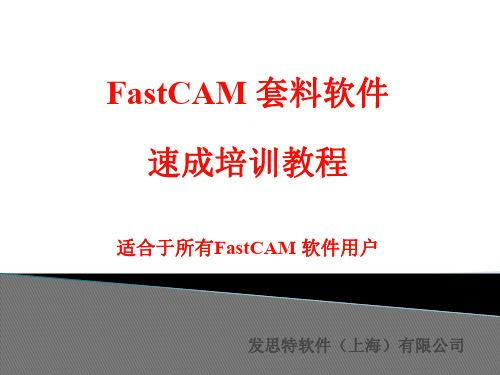
FastCAM绘图练习题
休息5分钟
第三讲:手动编程 第四讲:自动编程
(所需时间:15分钟) (所需时间:30分钟)
一、FastPATH 设置
(在桌面上看不到,在使用CAM模块或NEST模块时会被调用。) 主要的功能: 设置数控切割工艺:全自动设置零件的切割路径,提高工作效率。 自动设置引入引出线,设置割缝补偿,设置各种切割工艺,包括共 边,桥接和连续切割工艺。
1. 切割路径效验
2. 成本核算
手动编程练习
1、将《练习1.CAM》经过处理后通过手动方法输出NC码,并观察。 2、将《练习2.dxf》经过处理后通过手动方法输出NC码,并观察。 要求:切割过程为CUTTING,引入线类型为直线(同时测试为半圆/四分之一圆的 情况),长度为8,角度为0[同时测试角度为90,来观察变化情况],无引出线。
练习二
查看<<练习2.CAM>>,对于这个图形应该只有18个实体,请检查为什么?
FASTCAM绘图模块(即桌面FastCAM图标) 掌握点: ⑴.点、线、弧的应用与学习 ⑵. 删除、修剪、块操作、显示、工具及文字的学习 ⑶. 文字、效验、标准件等操作及应用
一、绘图功能练习
一、绘图功能练习
二、 手动套料
1、 参数设置: (输入格式、输出格式、套料参数、手动套料菜单)
二、 手动套料
1、 参数设置: (板材设置、套排料保存和读取方式)
二、 手动套料
二、 手动套料
一、 自动套料
二、 自动交互式套料
手动套料练习
1、将《工件4.CAM》使用手动套排料方法后输出NC码,并观察。 要求:设置自动FastPATH 工艺。 2、将《工件3.DXF》使用手动套排料方法后输出NC码后,用FastPLOT观察切割顺序 ,切割中与变形情况,同时查看一下成本内容并做好记录等。 要求:设置自动FastPATH 工艺。
Tutorial_1_solutions
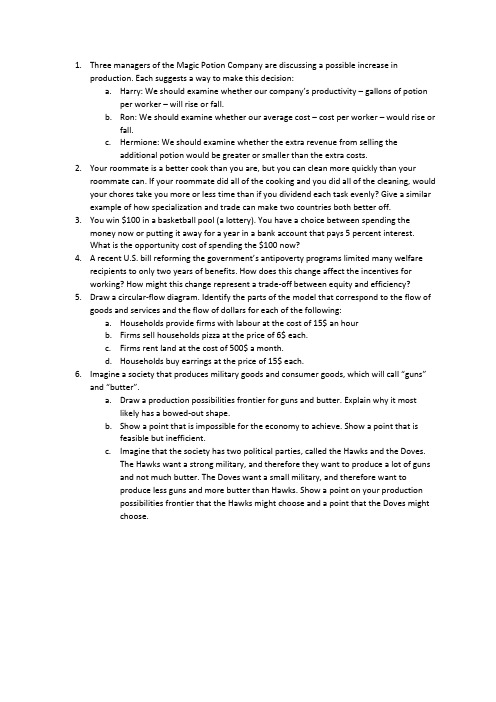
1.Three managers of the Magic Potion Company are discussing a possible increase inproduction. Each suggests a way to make this decision:a.Harry: We should examine whether our company’s productivity – gallons of potionper worker – will rise or fall.b.Ron: We should examine whether our average cost – cost per worker – would rise orfall.c.Hermione: We should examine whether the extra revenue from selling theadditional potion would be greater or smaller than the extra costs.2.Your roommate is a better cook than you are, but you can clean more quickly than yourroommate can. If your roommate did all of the cooking and you did all of the cleaning, would your chores take you more or less time than if you dividend each task evenly? Give a similar example of how specialization and trade can make two countries both better off.3.You win $100 in a basketball pool (a lottery). You have a choice between spending themoney now or putting it away for a year in a bank account that pays 5 percent interest.What is the opportunity cost of spending the $100 now?4. A recent U.S. bill reforming the government’s antipoverty programs limited many welfarerecipients to only two years of benefits. How does this change affect the incentives forworking? How might this change represent a trade-off between equity and efficiency?5.Draw a circular-flow diagram. Identify the parts of the model that correspond to the flow ofgoods and services and the flow of dollars for each of the following:a.Households provide firms with labour at the cost of 15$ an hourb.Firms sell households pizza at the price of 6$ each.c.Firms rent land at the cost of 500$ a month.d.Households buy earrings at the price of 15$ each.6.Imagine a society that produces military goods and consumer goods, which will call “guns”and “butter”.a.Draw a production possibilities frontier for guns and butter. Explain why it mostlikely has a bowed-out shape.b.Show a point that is impossible for the economy to achieve. Show a point that isfeasible but inefficient.c.Imagine that the society has two political parties, called the Hawks and the Doves.The Hawks want a strong military, and therefore they want to produce a lot of gunsand not much butter. The Doves want a small military, and therefore want toproduce less guns and more butter than Hawks. Show a point on your productionpossibilities frontier that the Hawks might choose and a point that the Doves mightchoose.1.Harry suggests looking at whether productivity would rise or fall. Productivity is certainly important,since the more productive workers are, the lower the cost per gallon of potion. Ron wants to look at average cost. But both Harry and Ron are missing the other side of the equation– revenue. A firm wants to maximize its profits, so it needs to examine both costs and revenues. Thus, Hermione is right – it is best to examine whether the extra revenue would exceed the extra costs. Hermione is the onlyone who is thinking at the margin.2.By specializing in each task, you and your roommate can finish the chores more quickly. If yo u dividedeach task equally, it would take you more time to cook than it would take your roommate, and it would take him more time to clean than it would take you. By specializing, you reduce the total time spent on chores. Similarly, countries can specialize and trade, making both better off. For example, suppose it takes Spanish workers less time to make clothes than French workers, and French workers can make wine more efficiently than Spanish workers. Then Spain and France can both benefit if Spanishworkers produce all the clothes and French workers produce all the wine, and they exchange wine forclothes.3.If you spend $100 now instead of saving it for a year and earning 5 percent interest, you aregiving up the opportunity to spend $105 a year from now.4. a. When welfare recipients have their benefits cut off after two years, they have a greater incentive tofind jobs than if their benefits were to last forever.b. The loss of benefits means that someone who cannot find a job will get no income at all, so thedistribution of income will become less equal. But the economy will be more efficient, because welfare recipients have a greater incentive to find jobs. Thus, the change in the law is one that increasesefficiency but reduces equity.5.Please see figure below:6.Please see graph below:a.The graph shows a production possibilities frontier between guns and butter. It is bowed out becausethe opportunity cost of butter depends on how much butter and how many guns the economy isproducing. When the economy is producing a lot of butter, workers and machines best suited to making guns are being used to make butter, so each unit of guns given up yields a small increase in theproduction of butter. Thus, the frontier is steep and the opportunity cos t of producing butter is high.When the economy is producing a lot of guns, workers and machines best suited to making butter are being used to make guns, so each unit of guns given up yields a large increase in the production of butter. Thus, the frontier is very flat and the opportunity cost of producing butter is low.b.Point A is impossible for the economy to achieve; it is outside the production possibilities frontier.Point B is feasible but inefficient because it is inside the production possibilities frontier.c.The Hawks might choose a point like H, with many guns and not much butter. The Dovesmight choose a point like D, with a lot of butter and few guns.。
LabSolutions 入门指南

223-60322Feb. 2011 LC 入门指南2本指南版权归株式会社岛津制作所所有。
未经本公司许可不得转载、复制部分或全部内容。
本指南内容如有改动恕不另行通知。
本指南内容力求准确,如有错误或遗漏敬请原谅。
本产品备件的供货期为产品停产后七年。
其后可能无法提供备件,请谅解。
但是,非本公司生产备件的供货期请参照相关厂家的规定。
计算机硬盘中的内容有时会因意外情况而丢失。
请务必备份以保护数据。
如果用户或使用场所发生改变,请将本指南转交给后续用户。
© 2011 Shimadzu Corporation. All rights reserved.••••••声明本指南是英文版《LabSolutions LC 入门指南》(223-60086)(修订版A2010年7月) 的译文。
3LabSolutions 随附有五种使用说明书。
您还可以显示 [帮助] 菜单来确认各参数的含义以及设置范围。
以下内容对如何充分利用这些说明书进行说明。
入门指南本指南供新手用户使用。
请按照本指南中所述步骤的顺序进行分析,以了解基本的 LabSolutions 操作。
操作说明书本说明书提供有关 LabSolutions 中总体数据采集操作的综合信息,例如,系统配置、数据处理、批处理以及报告功能。
管理说明书本说明书供系统管理员使用。
本说明书对系统管理和数据管理进行说明。
理论说明书本说明书对样品成分的峰检测和定量进行说明 (供高级用户使用)。
安装维护说明书本说明书对 LabSolutions 软件的安装和维护进行说明。
帮助参照 [帮助] 可了解有关所显示子窗口的更多信息。
可单击屏幕上的 [帮助] 按钮或键盘上的 [F1] 键显示[帮助]。
说明书中所用符号的含义如下所示。
•创建和打印各种自定义报告系统结构本系统指南就系统使用以下设备采集数据时进行说明。
4文件类型数据文件 (.lcd)该文件包含来自以下文件的所有分析结果和数据采集信息。
Tutorial 使用指南
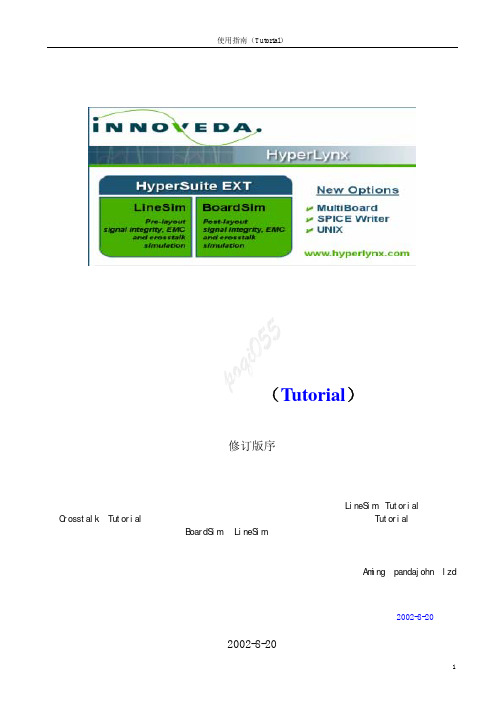
使用指南(Tutorial)修订版序从首次接触这个软件到现在,有一段时间了。
那时由于急着使用,因此对一些认为不太重要的地方没有进行整理。
后来才发现,其实每一部分都是很有用的。
此修订,一个是将LineSim(Tutorial)与后加的Crosstalk(Tutorial)的目录统一起来,再有就是原文基础上增加了多板仿真(Tutorial)一节。
同样,对于那一时期我整理的BoardSim 、LineSim使用手册,也有同样的一个没有对一些章节进行翻译整理问题(当初认为不太重要)。
而实际上使用时,有一些东西是非常重要的,同时也顺便进行了翻译。
此外,通过使用,对该软件有了更多一些理解,显然以前只从字面翻译的东西不太好理解,等我有时间将它们重新整理后,再提供给初学的朋友。
对在学习中给予我大量无私帮助的Aming、pandajohn、lzd 等网友表示忠心的感谢。
P o q i0552002-8-202002-8-20目录使用指南(TUTORIAL ) 1 第一章 LINESIM4 1.1 在L INE S IM 里时钟信号仿真的教学演示 4 第二章 时钟网络的EMC 分析 7 2.1 对是中网络进行EMC 分析7 第三章 LINESIM'S 的干扰、差分信号以及强制约束特性 8 3.1 “受害者”和 “入侵者” 8 3.2如何定线间耦合。
8 3.3 运行仿真观察交出干扰现象9 3.4 增加线间距离减少交叉干扰(从8 MILS 到 12 MILS ) 93.5 减少绝缘层介电常数减少交叉干扰 93.6 使用差分线的例子(关于差分阻抗) 93.7仿真差分线 10第四章 BOARDSIM114.1 快速分析整板的信号完整性和EMC 问题 11 4.2 检查报告文件 11 4.3 对于时钟网络详细的仿真 11 4.4 运行详细仿真步骤: 11 4.5 时钟网络CLK 的完整性仿真 12 第五章 关于集成电路的MODELS 145.1 模型M ODELS 以及如何利用T ERMINATOR W IZARD 自动创建终接负载的方法 14 5.2 修改U3的模型设置(在EASY.MOD 库里CMOS,5V,FAST ) 14 5.3 选择模型(管脚道管脚)C HOOSING M ODELS I NTERACTIVELY (交互), P IN -BY -P IN 14 5.4 搜寻模型(F INDING M ODELS (THE "M ODEL F INDER "S PREADSHEET ) 15 5.5 例子:一个没有终接的网络 15 第六章 BOARDSIM 的干扰仿真 186.1 B OARD S IM 干扰仿真如何工作 186.3仿真的例子:在一个时钟网络上预测干扰 18 6.3.1加载本例的例题“DEMO2.HYP” 18 6.3.2A UTOMATICALLY F INDING "A GGRESSOR"N ETS 18 6.3.3为仿真设置IC模型 19 6.3.4查看在耦合区域里干扰实在什么地方产生的 19 6.3.5驱动IC压摆率影响干扰和攻击网络 20 6.3.6电气门限对比几何门限 20 6.3.7用交互式仿真"CLK2"网络 20 6.4快速仿真:对整个PCB板作出干扰强度报告 20 6.5运行详细的批模式干扰仿真 21第七章关于多板仿真237.1多板仿真例题,检查交叉在两块板子上网络的信号质量 23 7.2浏览在多板向导中查看建立多板项目的方法 24 7.3仿真一个网络A024 7.4用EBD模型仿真24HyperLynxHyperLynx是高速仿真工具,包括信号完整性(signal-integrity)、交叉干扰(crosstalk)、电磁屏蔽仿真(EMC)。
Tutorial_2_solutions
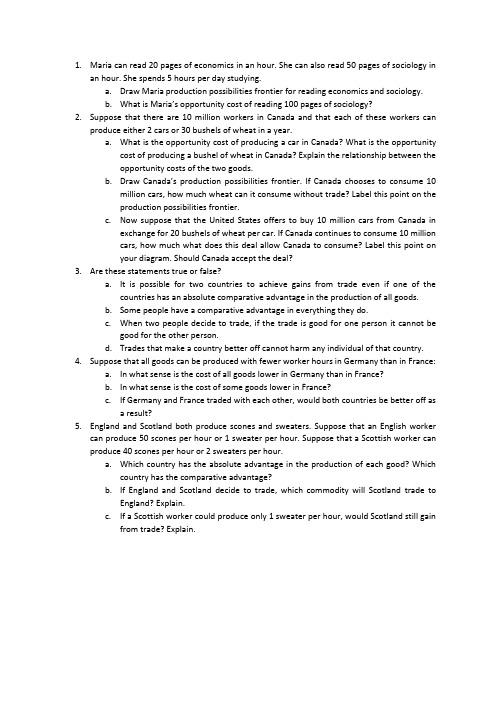
1.Maria can read 20 pages of economics in an hour. She can also read 50 pages of sociology inan hour. She spends 5 hours per day studying.a.Draw Maria production possibilities frontier for reading economics and sociology.b.What is Maria’s opportunity cost o f reading 100 pages of sociology?2.Suppose that there are 10 million workers in Canada and that each of these workers canproduce either 2 cars or 30 bushels of wheat in a year.a.What is the opportunity cost of producing a car in Canada? What is the opportunitycost of producing a bushel of wheat in Canada? Explain the relationship between theopportunity costs of the two goods.b.Draw Canada’s production possibilities frontier. If Canada chooses to consume 10million cars, how much wheat can it consume without trade? Label this point on theproduction possibilities frontier.c.Now suppose that the United States offers to buy 10 million cars from Canada inexchange for 20 bushels of wheat per car. If Canada continues to consume 10 millioncars, how much what does this deal allow Canada to consume? Label this point onyour diagram. Should Canada accept the deal?3.Are these statements true or false?a.It is possible for two countries to achieve gains from trade even if one of thecountries has an absolute comparative advantage in the production of all goods.b.Some people have a comparative advantage in everything they do.c.When two people decide to trade, if the trade is good for one person it cannot begood for the other person.d.Trades that make a country better off cannot harm any individual of that country.4.Suppose that all goods can be produced with fewer worker hours in Germany than in France:a.In what sense is the cost of all goods lower in Germany than in France?b.In what sense is the cost of some goods lower in France?c.If Germany and France traded with each other, would both countries be better off asa result?5.England and Scotland both produce scones and sweaters. Suppose that an English workercan produce 50 scones per hour or 1 sweater per hour. Suppose that a Scottish worker can produce 40 scones per hour or 2 sweaters per hour.a.Which country has the absolute advantage in the production of each good? Whichcountry has the comparative advantage?b.If England and Scotland decide to trade, which commodity will Scotland trade toEngland? Explain.c.If a Scottish worker could produce only 1 sweater per hour, would Scotland still gainfrom trade? Explain.1.a. See graph below. If Maria spends all five hours studying economics, she can read 100 pages, so that isthe vertical intercept of the production possibilities frontier. If she spends all five hours studying sociology, she can read 250 pages, so that is the horizontal intercept. The opportunity costs are constant, so the production possibilities frontier is a straight line.b. It takes Maria two hours to read 100 pages of sociology. In that time, she could read 40 pages ofeconomics. So the opportunity cost of 100 pages of sociology is 40 pages of economics.2.a. Because a Canadian worker can make either two cars a year or 30 bushels of wheat, the opportunity costof a car is 15 bushels of wheat. Similarly, the opportunity cost of a bushel of wheat is 1/15 of a car. The opportunity costs are the reciprocals of each other.b. See graph below. If all ten million workers produce two cars each, they produce a total of 20 million cars,which is the vertical intercept of the production possibilities frontier. If all ten million workers produce 30 bushels of wheat each, they produce a total of 300 million bushels, which is the horizontal intercept of the production possibilities frontier. Because the trade-off between cars and wheat is always the same, the production possibilities frontier is a straight line. If Canada chooses to consume ten million cars, it will need five million workers devoted to car production. That leaves five million workers to produce wheat, who will produce a total of 150 million bushels (five million workers times 30 bushels per worker). This is shown as point A in the graph.c. If the United States buys 10 million cars from Canada and Canada continues to consume10 million cars, then Canada will need to produce a total of 20 million cars. So Canadawill be producing at the vertical intercept of the production possibilities frontier. However, if Canada gets20 bushels of wheat per car, it will be able to consume 200 million bushels of wheat, along with the 10million cars. This is shown as point B in the figure. Canada should accept the deal because it gets the same number of cars and 50 million more bushels of wheat.3.a. True; two countries can achieve gains from trade even if one of the countries has an absolute advantagein the production of all goods. All that's necessary is that each country have a comparative advantage in some good.b. False; it is not true that some people have a comparative advantage in everything they do. In fact, noone can have a comparative advantage in everything. Comparative advantage reflects the opportunity cost of one good or activity in terms of another. If you have a comparative advantage in one thing, you must have a comparative disadvantage in the other thing.c. False; it is not true that if a trade is good for one person, it can't be good for the other one. Trades canand do benefit both sides especially trades based on comparative advantage. If both sides didn't benefit, trades would never occur.d. False; trade that makes the country better off can harm certain individuals in the country. For example,suppose a country has a comparative advantage in producing wheat and a comparative disadvantage in producing cars. Exporting wheat and importing cars will benefit the nation as a whole, as it will be able to consume more of all goods. However, the introduction of trade will likely be harmful to domestic autoworkers and manufacturers.4.a. The cost of all goods is lower in Germany than in France in the sense that all goods can be produced withfewer worker hours.b. The cost of any good for which France has a comparative advantage is lower in France than in Germany.Though Germany produces all goods with less labor, that labor may be more valuable in the production of some goods and services. So the cost of production, in terms of opportunity cost, will be lower in France for some goods.c. Trade between Germany and France will benefit both countries. For each good in which it has acomparative advantage, each country should produce more goods than it consumes, trading the rest to the other country. Total consumption will be higher in both countries as a result.5.a. English workers have an absolute advantage over Scottish workers in producing scones, since Englishworkers produce more scones per hour (50 vs. 40). Scottish workers have an absolute advantage over English workers in producing sweaters, since Scottish workers produce more sweaters per hour (2 vs. 1).Comparative advantage runs the same way. English workers, who have an opportunity cost of 1/50 sweater per scone (1 sweater per hour divided by 50 scones per hour), have a comparative advantage in scone production over Scottish workers, who have an opportunity cost of 1/20 sweater per scone (2 sweaters per hour divided by 40 scones per hour). Scottish workers, who have an opportunity cost of 20 scones per sweater (40 scones per hour divided by 2 sweaters per hour), have a comparative advantage in sweater production over English workers, who have an opportunity cost of 50 scones per sweater (50 scones per hour divided by 1 sweater per hour).b. If England and Scotland decide to trade, Scotland will produce sweaters and trade them for sconesproduced in England. A trade with a price between 20 and 50 scones per sweater will benefit both countries, as they'll be getting the traded good at a lower price than their opportunity cost of producing the good in their own country.c. Even if a Scottish worker produced just one sweater per hour, the countries would still gain from trade,because Scotland would still have a comparative advantage in producing sweaters. Its opportunity cost for sweaters would be higher than before (40 scones per sweater, instead of 20 scones per sweater before).But there are still gains from trade since England has a higher opportunity cost (50 scones per sweater).。
tutorial 中文手册2.2

感 谢本tutorial Manual 2.2翻译文档在许多网友的关心和支持下,得以翻译成功,在此对他们表示热烈地感谢:蝈蝈、fiona、kailinziv、Yan、杀毒软件、tiny0o0、timothy、prolee等关心TG手册翻译的热心朋友。
关于本文档内容说明:由于本手册由不同网友翻译,可能对某些概念有不同的理解,翻译可能不大一样,但决不影响理解,欢迎大家探讨。
再一次对各位网友的努力和汗水表示感谢!如有什么问题可以联系我:Mail:tiny0o0@注:本文档内容版权归X Y Z scientific company 所有,谢绝任何意图商用。
I、TrueGrid介绍True Grid是一套优秀的、功能强大的通用网格生成前处理软件。
它可以方便快速生成优化的、高质量的、多块结构的六面体网格模型。
作为一套简单易用,交互式、批处理前处理器,True Grid支持三十多款当今主流的分析软件。
True Grid是基于多块体结构(multiple-block-structured)的网格划分工具,尽管这个指南手册开始会提供一些介绍信息,新手还是强烈要求阅读用户手册(True Grid® User’s Manual)的前2章,用户指南和参考手册。
True Grid是几何和网格形成过程是分开进行。
曲面和曲线形成的方式有以下几种:内部产生,从CAD/CAE系统导出IGES格式导入TG,或用vpsd命令导入多边曲面。
块网格(block mesh)初始化然后通过各种变换与几何模型匹配形成最后的有限元模型。
True Grid网格划分过程:运用block命令初始化块网格;块网格部分会被删掉以使拓扑结构与划分目标对应;块网格部分通过移动,曲线定位,曲面投影等方法进行变换;网格插值、光滑和Zoning(控制边界节点分布)等技术可以用来形成更好的网格;块网格之间独立形成,然后通过块边界面(BB)和普通节点合并命令(指定容差范围内合并)将各块网格合并成完整的有限元模型。
ansys_tutorial
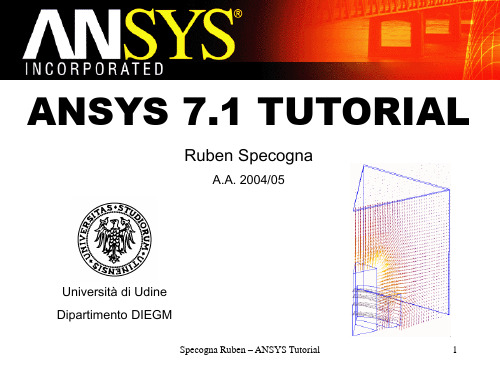
– SELECT
– RESELECT
– ALSO SELECT
– UNSELECT
– INVERT
– SELECT ALL
– SELECT NONE
Specogna Ruben – ANSYS Tutorial
10
Selezione 2/2
• Provate a selezionare ad Entità esempio l’area 12 e 14
• Si puòapplicate un diverso infittimento per ogni indice materiale
– vsel,s,mat,,2 – smrtsize,2 – vmesh,all – vsel,s,mat,,1 – smrtsize,7 – vmesh,all – eplot
• Lo script èun semplice file di testo ASCII che contiene una lista di comandi
• Una volta salvato il file con un qualsiasi editor di testi lo si può eseguire attraverso FILE->Read Input from…
Nodi
– asel,s,,,12
Elementi
– asel,a,,,14
Keypoints Linee
– S sta per SELECT
Aree Volumi
– A per ALSO SELECT
Componenti
Comando base
NSEL ESEL KSEL LSEL ASEL VSEL CMSEL
tutorial节选

Things to Know Before Getting Started with eQUEST Whole building analysis. eQUEST is designed to provide whole Building performance analysis to buildings professionals, i.e., owners, designers, operators, utility & regulatory personnel, and educators. Whole building analysis recognizes that a building is a system of systems and that energy responsive design is a creative process of integrating the performance of interacting systems, e.g., envelope, fenestration, lighting, HVAC, and DHW.在开始之前需要知道的事情与eQUEST关于整个建筑的分析。
eQUEST旨在提供整个建筑性能分析建筑专业人士,即所有者,设计师、运营商、实用工具和监管人员,和教育家。
从整个建筑分析认识到建筑是一个系统的系统和能量响应设计是一种创造性的整合过程性能交互的系统,例如,维护结构、开窗、照明、空调和DHW。
Therefore, any analysis of the performance consequences of these building systems must consider the inter actions between them … in a manner that is both compre hensive and affordable (i.e., model preparation time, simulation runtime, results trouble shooting time, and results reporting).因此,任何分析的性能影响这些建筑系统必须考虑…它们之间的交互的方式,既全面和负担得起的(例如,模型的准备时间,模拟运行时间,结果故障排除时间,和结果报告)。
Tiamo操作
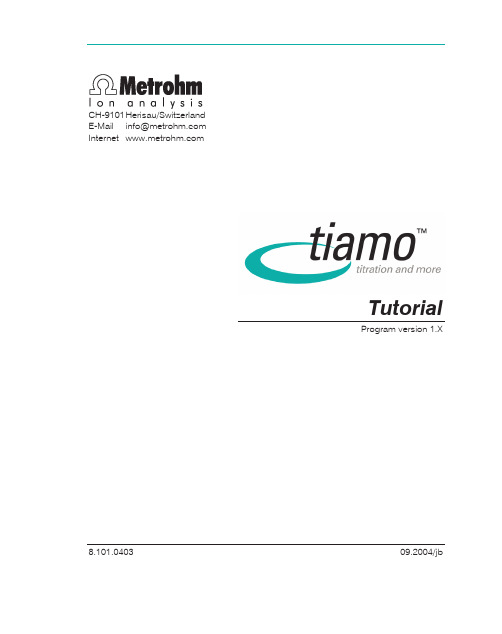
E-Mail info@Internet TutorialProgram version 1.X8.101.0403 09.2004/jbTeachwareMetrohm AGOberdorfstrasse 68CH-9101 Herisauteachware@This tutorial is protected by copyright. All rights reserved.Although this tutorial has been prepared with the greatest care, errors cannot be com-pletely excluded. Should you notice any please contact the above address.ITable of contents1 Introduction (1)2 Titration without automation (3)2.1 Configuration (3)2.1.1Connecting the titrator.....................................................3 2.1.2Configuring the titrant......................................................7 2.1.3Configuring a pH sensor (11)2.1.4 Preparing the exchange or dosing unit (12)2.2 Methods (14)2.2.1 Creating a titration method (14)2.2.2 Carrying out a titration (22)2.3 Database (25)2.3.1Overview........................................................................25 2.3.2Adapting the layout........................................................26 2.3.3Reprocessing a determination (28)2.3.4 Report printout...............................................................29 3 Titration with automation. (31)3.1 Configuration (31)3.1.1Connecting a Sample Processor...................................31 3.1.2Connecting a balance...................................................33 3.1.3Assigning lift positions...................................................34 3.1.4Defining special beakers...............................................37 3.2 Method. (39)3.2.1Creating an automation method ...................................39 3.2.2Creating a sample table................................................46 3.2.3Processing a sample series (49)3.2.4 Extending the automation method (51)IIIntroduction 11 IntroductionThis tutorial describes the first steps with tiamo . You will be intro-duced to the most important operating features by using a simple pHtitration as an example.Detailed information about tiamo can be found in the online help (). F1 opens the help for the particular dialog.The tutorial is arranged in two parts:Part 1: Titration without automationConfiguration- Connecting a Titrando or a Titrino- Adding a titrant- Connecting a pH electrodeMethod- Drawing up a method using a template- Carrying out a titrationDatabase- Result view in the determination database- Reprocessing the determination- Printing a reportPart 2: Titration with automationYou will learn how to insert a Sample Processor in an existing titrationsystem and how to configure it. The titration method used in Part 1 isadapted accordingly in a few steps. For carrying out a determinationseries the creating of a sample table is explained.2IntroductionTitration without automation 32 Titration without automationThe following instruments are required for the titration describedbelow:•Titrando or Titrino •Exchange unit or Dosino with dosing unit • Stirrer 2.1 Configuration2.1.1 Connecting the titratorConnecting a Titrando with stirrer:Connect a stirrer and – if available – an external dosing device to an MSB-connection of the Titrando.Use the 6.2151.000 Cable to connect the controller socket of the Titrando with a USB connection on the computer.Start tiamo . The Titrando is recognized automatically:After confirming the message a dialog window containing the deviceproperties opens automatically:4 Titration without automationUnder Device name enter a name that describes the Titrando unambiguously; confirm it with [OK].Connecting a Titrino: Note! Titrinos are not recognized automatically and must be enteredmanually in the device table.Connect your Titrino to the PC via the RS232 interface COM1,COM2... (6.2125.110 Cable 9 p./f. – 25 p./f or 6.2134.040 9 p./f. – 9 p./f) and switch it on.Now start tiamo .By clicking on the symbol [Configuration] you will access an over-view showing all the connected devices, titrants and sensors.Select Edit, New… in the subwindow "Devices". The dialog shows all the devices that can be connected via an RS232 inter-face opens:Titration without automation5Select your Titrino from the list and press [OK]. The properties window of the selected device opens automatically:Under Device name enter a name that describes the Titrino unambiguously.On the RS 232 register card select the interface on the PC to6 Titration without automation which you have connected the Titrino and confirm it with [OK].2.1.2 Configuring the titrantConfiguring a titrant in an intelligent exchange or dosing unitwith data chipNote!The following description only applies if a Titrando is used.For Titrinos: please refer to next section.Attach the exchange unit to the Titrando or the Dosino to the dosing unit.As soon as the exchange or dosing unit has been recognized thefollowing message appears:After confirming this message you will be requested to carry out the Prepare function, with which all the tubing and the cylinder are rinsed:Preparing the exchange or dosing unit is described in Section 2.1.4. However, the exchange or dosing unit must first be configured.If you are not yet in the configuration view click on the symbol [Configuration]. This accesses an overview showing all the connected devices, titrants and sensors.The new titrant is entered in the List of titrants:The properties window is opened with a double-click on the new titrant:Enter a Solution name or select one from the list.Now define the Concentration of your titrant.Switch on the option Solution monitoring and enter e. g. 60 days as the working life.Confirm the entry with [OK].Configuring a titrant in an exchange or dosing unit without data chip:A titrant in an exchange or dosing unit without data chip must be added manually to the solution table. The exchange or dosing unitdoes not need to be attached for this.Note!If you use an exchange unit with data chip with a Titrino you will also have to enter the titrant in the solution table manually.If you are not yet in the configuration view click on the symbol [Configuration].Select Edit, New, Exchange or Dosing unit… in the subwindow "Titrants/Solutions". The dialog win-dow containing the properties of the titrant opens:Enter a Solution name or select one from the list.Now define the Concentration of your titrant.Switch on the option Solution monitoring and enter e. g. 60 days as the working life.On the register card Dosing unit or Exchange unit select the Cylinder volume and enter the number printed on the cylinder under Cylinder serial number.Confirm the entries with [OK].2.1.3Configuring a pH sensorIn the subwindow "Sensors" select Edit, New, pH electrode…. The dialog window containing the properties of the sensor opens:Enter the Sensor name and the Order number .On the register card Calibration data switch on the option Calibration data monitoring and enter a calibration interval of e. g. 7 days.Confirm the entries with [OK].2.1.4 Preparing the exchange or dosing unitOpen manual operation via the menu Tools, Manual control or directly via the symbol bar with:Mark the dosing device in the left-hand window and change to the register card Prepare .Note!Make sure that the buret tip is directed into a container that can accommodate the volume of your exchange or dosing unit several times over.Start rinsing the tubing with [Start]. The following message appears:Confirm the security query with [Yes].Preparation is carried out with standard parameters and is different for exchange units and dosing units.When preparation has been completed exit manual operation with [Close].2.2 Methods2.2.1 Creating a titration methodBelow you will find a description of how to use a template to createyour own method for DET pH titrations.Click on the symbol [Method]. The method editor is shown. Use File, New… to open the selection list of method tem-plates and under the item Titration select Dynamic titration pH. After confirmation with [OK] the method is loaded.The method template consists of the titration command DET pH, the calculation command CALC, the command REPORT for print-ing a determination report and the command DATABASE for sav-ing the determination in the database.The method is now already complete except for a few parameterswhich you are just going to set.Open the parameter window of the titration command DET pHwith a double-click:Under Device nameselect the connected Titrando or Titrino.Under Dosing device select the MSB connection to which the dosing device has been connected. Select MSB 1 if you have attached an exchange unit to the Titrando / Titrino. Se-lect your newly configured titrant under Solution.Select your previously configured pH electrode under Sen-sor.Under Stirrer select the MSB connection to which the stirrer has been connected.As stop criterion select Stop EP = 1 and Volume after EP = 1 mL and confirm the alterations with [OK].Open the parameter window of the calculation command CALCwith a double-click:Press [New]. The dialog window "New result" is shown:In this window predefined result templates can be loaded and adapted for new calculations. As you have not yet defined a templatethe selection is empty.Press [Next >>]. The parameter window for the new result opens:Open the formula editor with :The calculation formula is entered in the upper part of the window. Beneath it the most important mathematical functions are shown as symbols. In the subwindow "Variables" all the variables that are available for this method are listed in a tree structure. In the subwin-dow "Operators/Functions" further mathematical functions can be selected. A short description is shown for each variable and function. The following steps describe how you can enter the simple formula shown below for determining the content of a sample:'DET pH.EP{1}.VOL': EP volume for 1st endpoint'DET pH.CONC': Titrant concentration'DET pH.TITER': Titer of titrant40.00: Equivalent mass of sample, NaOH as an example0.1: Factor for conversion to %'MV.Sample Size: Sample sizeSelect the variable "VOL" for the endpoint volume under the item Command variables, DET pH, EP{x}.Press [Insert] to accept the variable in the formula. 'DET pH.EP{x}.VOL'Replace the "x" by "1", i.e. this variable corresponds to the end-point volume of the 1st endpoint.Insert the multiplication sign via the corresponding symbol or with the keyboard.In the same way insert the variables "CONC" and "TITER".Enter the equivalent molar mass of the sample as well as theconversion factor.Select the variable "Sample size" under the item Method vari-ables and insert it in the formula with [Insert].Confirm the entries with [OK]. The formula editor is closed and you again find yourself in the parameter window for the new re-sult.As Unit select %. Confirm the entry with [OK]. The calculation is entered in the result table.Close this dialog with [OK].Open the parameter window of the report command REPORT with a double-click:Deactivate the option Printer.Activate the option PDF-file and after clicking on enter the path and the file name under which the report is to be saved. Confirm the entry with [OK].Open the parameter window of the database command DATA-BASE with a double-click:Use [New] to select the standard database tiamo and confirm with[OK].Close this dialog with[OK].The method is now ready and can be checked with a method check and then saved:Start checking the method via the menu File, Method check or directly via the tool bar with . If the method test is success-fully concluded the following message will appear:Confirm the message with [OK].Save the new method with File, Save as...:Enter "Tutorial" as the Method name and press [Save].2.2.2Carrying out a titrationChange to the workplace view.In the subwindow "Run" under Method select the method you have just saved: "Tutorial":Enter the Sample size , e. g. "5.0" and select the Unit "g".Place a sample on the stirrer and immerse the pH electrode andburet tip in it.Press [Start] to start the titration. The currently active command is marked with a red border.While the titration is being carried out you are going to configure the live display so that you can follow both the titration curve and the current measured value directly:With right-hand click in the subwindow "Live display" the prop-erties window opens:Activate the parameter Measured value display and confirm the alteration with [OK].The live display now looks like this:With the symbol in the top right-hand corner of the live displayyou can enlarge the window or diminish it again.As soon as the determination has finished this will be shown in the live display by:In the subwindow "Report" a preview of the report is shown. Printing out the report is described in the following section.2.3 Database2.3.1 OverviewChange to the database view.Open the standard database tiamo under File, Open.... The database is divided up into different windows. The standardsetting looks like this:In the subwindow "Determination overview" the single determina-tions are listed in tabular form, sorted according to date and time. In the lower half of the screen the titration curve and the calculated result are shown in separate windows. In the subwindow "Informa-tion" general information about the determination, such as determi-nation start, method information, sample data, system configuration,etc. is shown.2.3.2 Adapting the layoutA short description is given about how to adapt the database view toyour own requirements. Reprocessing a determination is illustratedafterwards by a simple example.Use a right-hand click on the subwindow "Curves" to open the properties window for the curve view.On the register card Options activate the parameter Show grid.Confirm the alteration with [OK].The titration curve is shown with a grid.In the subwindow "Determination overview" you can define which columns are to be shown. You can also freely select the order in which the columns are to be shown:For example, the columns User (Short name) and Remarks are to be deleted and then the column Method nameis to be moved:Via the menu View, Properties, Column dis-play open the dialog window Column display:Select the column User (Short name).Remove this column from the view by pressing [<<].Proceed in the same way for the column Remarks.Confirm the alteration with [OK]. The two columns are no longer shown.In the subwindow "Determination overview" click on the col-umn title Method name and move this column to the right with the mouse key pressed down to insert it after the column Re-sult column RS01.Unit (drag & drop).2.3.3 Reprocessing a determinationOpen the dialog window for reprocessing determinations underDeterminations, Reprocess… or directly with the symbol :For practice alter the sample size from 5.0 g to 10.0 g:Select line 9 and press [Modify]:Enter the new value 10.0 for the sample size and confirm it with[OK].Trigger the recalculation with [Recalculate]. The progress is shown by a progress bar.The new result is shown in the right-hand part of the window.Close the dialog window with [OK]. The recalculated determination is saved as a new version.2.3.4 Report printoutThe PDF report automatically generated by the determination can beprinted out directly from the database view:Under File, Print, Report… select Original report and the required printer and confirm with [OK]:The report is now printed out.Note!If the determination has been recalculated as in this example, the report of the recalculated determination is printed out.3 Titration with automationFor the second part of this tutorial you require a Sample Processor, astirrer and a balance in addition to the titrator.3.1 Configuration3.1.1 Connecting a Sample ProcessorConnecting a Robotic USB Sample ProcessorConnect a stirrer to the stirrer connection of the tower.Use the Cable 6.2151.000 to connect the controller socket of theRobotic USB Sample Processor to a USB connection on thecomputer or Titrando.Start tiamo. The USB Sample Processor is recognized automati-cally:After confirming the message the dialog window containing the de-vice properties opens automatically:Under Device name enter a name that describes the Robotic USB Sample Processor unambiguously and confirm it with [OK].Connecting a Sample Processor via an RS232 interfaceNote!Sample Processors that are connected to the PC via the RS232 interface (e.g. 778 Sample Processor) are not recognized auto-matically and must be entered in the device table manually.The connection is identical to connecting a Titrino (see Sec-tion 2.1.1).3.1.2 Connecting a balanceNote!Balances are not recognized automatically and must be entered inthe device table manually.The connection is identical to connecting a Titrino (see Sec-tion 2.1.1).For unambiguous identification in addition to the Device nameyou must also enter the Serial number of the balance.Set the connection parameters on the register card RS 232. Youcan find the corresponding values in the Instructions for Use ofyour balance.Press [Check connection]. The following dialog window is opened:Press the [Print] key on the balance in order to check the con-nection. If the correct connection parameters have been en-tered, the parameter fields Device name, Sample size and Sample size unit will be filled in with the corresponding data. Confirm with [OK].Close the parameter window of the balance with [OK].3.1.3 Assigning lift positionsIn this section you will learn how to define lift positions. This is neces-sary so that the subsequent titration can be carried out with theSample Processor.Equip the titration head with all the necessary accessories suchas electrode, dosing tip, etc., that you require for your daily workwith the Sample Processor and place a sample vessel at Posi-tion 1.Open manual operation under Extras, Manual operation ordirectly via the symbol bar with :The connected titrators and Sample Processors are shown on the leftwith their peripheral devices. On the right the functions of the markeddevice are shown, in this example for the tower of an 815 Robotic USB Sample Processor XL.Mark the tower of the Sample Processor that you wish to use and click on the register card Move.Note!After initialization the Sample Processor is not at a valid rack posi-tion. This is indicated under Current position by Invalid.Under Rack position use [Start] or [t] to move to Position 1.You can move the lift by using the arrow keys [u] and [v] under the parameter Lift position. Set the lift height that you want to use as the work position, i.e. one at which the electrode is im-mersed.Change to the register card Assign position:The current lift height is entered under Lift position. The option Work position for Tower is preselected.Now press [Assign].Now define a shift position:Change back to the register card Move and use the [u] key to move the lift up so far that the rack can rotate freely without damaging the electrode or sample beaker.Change to the register card Assign position and select the option Shift position for Tower under Lift position and press [Assign].Define a rinse position in the same way.Now check your settings:Change to the register card Move:Under Lift position select the target position Work position and press [Start]. The lift should now move to the height that has just been defined.Check the shift and rinse position in the same way.3.1.4 Defining special beakersSpecial beakers are particular rack positions which, e.g. can be usedfor rinsing or as conditioning beakers. Special beakers are preferablyset at high rack positions so that sample series can start from rackposition 1. Lift positions must be separately assigned for specialbeakers.Enter the required position on the register card Move under Rack position and press [Start]. The rack position is moved to. Change to the register card Assign position.The current position is entered under Rack position.For Special beaker select "1" for the first special beaker and press [Assign].Define a second special beaker position in the same way.Now check the settings:Change again to the register card Move.Under Rack position select the target position Special beaker 1 from the selection list and press [Start]. The rack po-sition that has just been defined will be moved to. Check the second special beaker position as well. Now define a work position for each special beaker: Move to special beaker 1 as described above.Use the arrow keys [u] and [v] under the parameter Lift posi-tion to move the lift. Set the lift height that you want to use as the work position, i.e. so that the electrode is immersed.Change to the register card Assign position:Under Lift position select Special beaker 1 for the work posi-tion.Now press [Assign].In the same way define a work position for special beaker 2. Now check the settings.Then close manual operation with [Close].3.2 Method3.2.1 Creating an automation methodThe method created in part 1 is to be extended to become an auto-mation method so that a sample series can be processed automati-cally.Click on the symbol [Method]. The method editor is shown.Use File, Open… to open the saved method "Tutorial" if it is not already open.Meaning of the individual commandsThe following commands are required for a simple automationmethod:The command MOVE moves to a rack position or an external posi-tion (only with Swing Head).The command LIFTmoves the lift to the required height.With the command STIR a stirrer connected to the Sample Proces-sor is switched on and off.The command PUMP switches an internal or external pump at the Sample Processor on and off.Extending the titration methodInsert a command before the titration command DET pH to move to the first sample:Mark the command DET pH. The command is shown with a black border.Under Insert, New command… select the command MOVE under the item Automation and confirm it with [OK].The command is inserted before the DET pHcommand.Open the parameter window of the command MOVE with a double-click:Under Device name select the connected Sample Proces-sor. The other parameters are already set correctly and do not need to be altered.Confirm the alteration with [OK].Now insert the command LIFT after the MOVE command in order to move the lift to the work position:Mark the command DET pH again. The command is shown with a black border.Under Insert, New command… select the command LIFT under the item Automation and confirm it with [OK].Open the parameter window of the command LIFT with a double-click:Under Device name select the connected Sample Proces-sor. The other parameters are already set correctly and do not need to be altered.Confirm the alteration with [OK].Now insert the command STIR after the LIFT command in the same way to switch the stirrer on.Open the parameter window of the command STIR with a double-click:Under Device name select the connected Sample Proces-sor. The other parameters are already set correctly and do not need to be altered.Confirm the alteration with [OK].As the stirrer is controlled by the STIR command, it must be switched off in the titration command DET pH :On the register card General/Hardware under Stirrer select the option "off" and accept the alteration with [OK].Insert a STIR command before the END command to switch off the stirrer at the end of the titration and open its parameter window.Under Device name select the connected Sample Proces-sor.Under Action select the option "Switch off".Confirm the alteration with [OK].In the following steps you will insert the commands MOVE , LIFT and PUMP in order to rinse electrode, dosing tip and stirrer inspecial beaker 1:Insert a MOVE command before the END command and open its parameter window.Under Device name assign it to the connected SampleProcessor.Under Target and the parameter Move select the option Special beaker . Under Number "1" is already preselected for the first special beaker.Confirm the alteration with [OK].Insert a LIFT command after the MOVE command and open its parameter window.Under Device name select the connected Sample Proces-sor. The other parameters are already set correctly and do not need to be altered.Confirm the alteration with [OK].Insert a PUMP command after the LIFT command and open its parameter window:Under Device name select the connected Sample Proces-sor.Under Pump(s) select "1+2"in order to switch on both pumps. For built-in pumps pump 1 is used for rinsing the ti-tration head and pump 2 is used for sucking off the solution in order that the special beaker is not overflowing.Under Action select the option Duration and enter the time "3 s".Confirm the alteration with [OK].Open the parameter window of the command START with a double-click:Activate Statistics and enter the number "3".Confirm the alteration with [OK].The method is now ready and can be checked with a method test and then saved:Start the method check via the menu File, Method check ordirectly via the symbol bar with . If the method test has been completed successfully the following message will be shown:Confirm the message with [OK].Save the method under File, Save as... and enter "Tutorial Automation" as the method name.Press [Save].3.2.2 Creating a sample tableYou will now create a sample table in order to carry out a series ofthree determinations fully automatically. In a second step the samplesize will be transferred directly from the balance to the sample table. Change to the workplace view.Click on the register card Determination series in the subwin-dow "Sequence":Under Sample data open the input window for the individual samples with a double-click on the marked line:。
- 1、下载文档前请自行甄别文档内容的完整性,平台不提供额外的编辑、内容补充、找答案等附加服务。
- 2、"仅部分预览"的文档,不可在线预览部分如存在完整性等问题,可反馈申请退款(可完整预览的文档不适用该条件!)。
- 3、如文档侵犯您的权益,请联系客服反馈,我们会尽快为您处理(人工客服工作时间:9:00-18:30)。
1.An improvement in technology lowers the cost of producing DVD recorders. Explain whathappens to consumer surplus in the market for DVD recorders. Illustrate your answers with diagrams.2.Suppose the demand for French bread rises. Explain what happens to producer surplus in themarket for French bread. Explain what happens to producer surplus in the market for flour.Illustrate your answers with diagrams.3.Regis is hungry for a snack. Here is the value he places on a cupcake:Value of 1st cupcake $5Value of 2nd cupcake $4Value of 3rd cupcake $3Value of 4th cupcake $2a.From this schedule, derive Regis’ demand schedule. Graph his demand curve forcupcakes.b.If the price of a cupcake is $3.50, how many cupcakes does Regis buy? How muchconsumer surplus does Regis get from his purchase? Show his consumer surplus in yourgraph.c.If the price falls to $2.50, how does quantity demanded change? How does Regis’consumer surplus change? Show these changes in your graph.4.The cost of producing stereo systems has fallen over the past several decades. Let’s considersome implications of this fact.a.Draw a supply-and-demand diagram to show the effect of falling production costs on theprice and quantity of stereo sold.b.In your diagram, show what happens to consumer surplus and producer surplus.c.Suppose the supply of stereos is very elastic. Who benefits most from falling productioncosts – consumers or producers of stereos?5.The supply and demand for ice cream cones are described by the following equations:Supply: Q S = -30 + 38PDemand: Q D = 90 – 2PQ is the quantity of ice cream cones per day, and P is the price per cone (in dollars).a.Graph the supply curve and the demand curve. What is the equilibrium price andquantity?b.Calculate consumer surplus, producer surplus, and total surplus at the equilibrium.c.If a dictator who hated ice cream were to outlaw the sale of ice cream cones, who wouldbear the larger burden – the buyers or the sellers of ice cream cones?1. If there is an improvement in the technology of producing DVD recorders, the supply curve for DVDrecorders shifts to the right, as shown in Figure 1. The result is a fall in the price of DVD recorders and a rise in consumer surplus from A to A + B + C. So consumer surplus rises by the amount B + C.2. A rise in the demand for French bread leads to an increase in producer surplus in the market for Frenchbread, as shown in Figure 2. The shift of the demand curve leads to an increased price, which increases producer surplus from area A to area A + B + C.Figure 2.The increased quantity of French bread being sold increases the demand for flour, as shown in Figure 3. As a result, the price of flour rises, increasing producer surplus from area D to D + E + F. Note that an event that affects producer surplus in one market leads to effects on producer surplus in related markets.P r i c e o f D V D r e c o r d e r sQuantity of DVD recordersFigure 3.3.a.Regis’s demand schedule is:Price Quantity DemandedMore than $5 0$4 to $5 1$3 to $4 2$2 to $3 3$2 or less 4Regis’s demand curve is shown in Figure 4.Figure 4.b.When the price of a cupcake is $3.50, Regis buys two cupcakes. His consumer surplus is shown asarea A in the figure. He values his cupcake at $5, but pays only $3.50 for it, so he has consumer surplus of $1.50. He values his second cupcake at $4, but pays only $3.50 for it, so he has consumer surplus of $0.50. Thus Regis’s total consumer surplus is $1.50 + $0.50 = $2, which is the area of A in the figure.c. When the price of a cupcake falls from $3.50 to $2.50, Regis buys three cupcakes, an increase of one.His consumer surplus consists of both areas A and B in the figure, an increase in the amount of area B.He gets consumer surplus of $2.50 from the first cupcake ($5 value minus $2.50 price), $1.50 from thesecond cupcake ($4 value minus $2.50 price), and $0.50 from the third cupcake ($3 value minus $2 price), for a total consumer surplus of $4.50. Thus consumer surplus rises by $2.50 (which is the size of area B) when the price of a cupcake falls from $3.50 to $2.50.4.a. The effect of falling production costs in the market for stereos results in a shift to the right in thesupply curve, as shown in Figure 5. As a result, the equilibrium price of stereos declines and the equilibrium quantity increases.b. The decline in the price of stereos increases consumer surplus from area A to A + B + C + D, anincrease in the amount B + C + D. Prior to the shift in supply, producer surplus was areas B + E (the area above the supply curve and below the price). After the shift in supply, producer surplus is areas E + F + G. So producer surplus changes by the amount F + G – B, which may be positive or negative.The increase in quantity increases producer surplus, while the decline in the price reduces producer surplus. Because consumer surplus rises by B + C + D and producer surplus rises by F + G – B, total surplus rises by C + D + F + G.Figure 5.c. If the supply of stereos is very elastic, then the shift of the supply curve benefits consumers most. Totake the most dramatic case, suppose the supply curve were horizontal, as shown in Figure 6. Thenthere is no producer surplus at all. Consumers capture all the benefits of falling production costs, with consumer surplus rising from area A to area A + B.Figure 6.5.a. The supply and demand curves are shown in Figure 7. The equilibrium price and quantity are foundby equating quantity demanded and quantity supplied:38P – 30 = 90 – 2P40P = 120P = $3.00Q = 84The equilibrium price is $3 per ice cream cone and the equilibrium quantity is 84 cones.Figure 7.b. At the market equilibrium, consumer surplus is equal to 0.5⨯($45 – $3)⨯84 = 0.5⨯(42$)⨯84 =$1,764. Producer surplus at market equilibrium is 0.5⨯($3 – $0.79) ⨯84 =0.5⨯ ($2.21) ⨯84 = $92.82.Therefore, total surplus is $1,764 + $92.82 = $1,856.82.c. If a dictator banned the sale of ice cream cones, producer and consumer surplus would both fall to $0.Buyers would be harmed more than sellers would because the decline in consumer surplus would be greater than the decline in producer surplus.。
